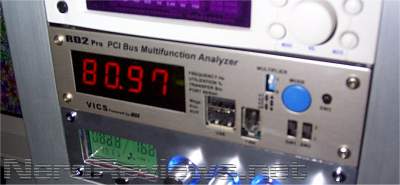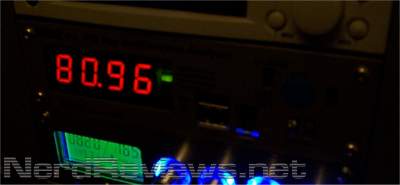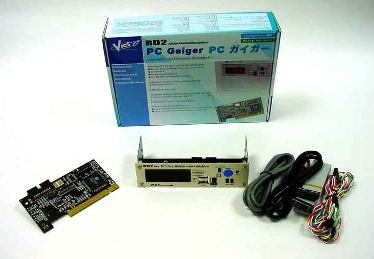RD2 PC-Geiger Review
By Bones (Ed T. Toton III)
October 29, 2003
(Review unit not supplied; purchased for use)
DESCRIPTION
The PC-Geiger is a drive-bay device that displays information
about your PCI bus in an easily understood and accessible manner.
It consists of a bare-metal panel with a red numeric LED display, and
a PCI connected PCI card for reading information from your motherboard.
It's capable of displaying bus speed in megahertz, as well as bus
utilization in kilobytes per second or megabytes per second, or
as a percentage. It will also display port 80H/84H boot codes.
Since the PC-Geiger simply monitors the status of the PCI bus
and does not otherwise communicate with your system, it is
theoretically independant of any particular operating system or
software, and does not require anyware, and does not require any
later.
This device also comes equipped with front-facing USB ports
and a fireware port, that can be connected to your motherboard
with included cables. The pin-by-pin connectors for the USB
cables allow them to be used on virtually any motherboard.


OBSERVATIONS
Installation of the PC-Geiger is very simple. It merely consists
of a drive-bay insert, and a PCI card that are connected via a
ribbon cable. There are other connectors on the back of the display
panel that can be used to connect it's auxilliary LED and switches
to certain functions on your motherboard, such as using one of the
switches as an externally accessible CMOS-clearing switch. These
are completely optional and are intended more for tinkerer's to
use for custom projects. To be able to directly use the device
for it's primary functions requires only connecting it to the
PCI card, which does most of the work.
Upon starting the system, you will immediately see the boot-codes
generated on the system bus displayed during POST (Power-On Self-Test).
A code of "FF" means that the BIOS (Basic Input/Output System) has
handed off control of the computer to the operating system and it
is beginning to boot your software.
The "mode" button can now be used to select other statistics to
display, such as the percentage of PCI-bus utilization. There are
only four modes, including the Port 80H/84H codes (boot codes).
Since there is no software to install, you can connect this to
a pre-configured machine running any operating system and not
be concerned with changing software configurations or interfering
with an existing setup. You can also easily migrate it from one
machine to another.
 However, there may be a caveat with regards to this software
independence. In our the system, we found that under Windows 2000
it operates just fine. However when the same machine (running
an AMD XP 2200+ and ASUS A7V8X MB) is booted into Linux
(Slackware 9.1 with default kernel), all of the functions of
the PC-Geiger are effectively inaccessible, since there are
apparently codes constantly being generated on Ports 80H/84H.
From what I'm told, the linux kernel outputs data to those ports
as IO-delays that are independant of CPU speed. Apparently it's
considered one of the few "safe" ports for this use. Unfortunately,
the PC-Geiger is designed to display those port codes at the exclusion
of all else when they're being generated, despite what you may
have selected. We feel this is a serious design flaw; that the
PC-Geiger should only monitor and store that information
in the background if you've elected to display something else.
This flaw can result in the PC-Geiger being effectively useless if
you're a linux user. If the PC-Geiger were better about honoring
your mode selection, the Linux kernel's activities would be a non-issue.
However, there may be a caveat with regards to this software
independence. In our the system, we found that under Windows 2000
it operates just fine. However when the same machine (running
an AMD XP 2200+ and ASUS A7V8X MB) is booted into Linux
(Slackware 9.1 with default kernel), all of the functions of
the PC-Geiger are effectively inaccessible, since there are
apparently codes constantly being generated on Ports 80H/84H.
From what I'm told, the linux kernel outputs data to those ports
as IO-delays that are independant of CPU speed. Apparently it's
considered one of the few "safe" ports for this use. Unfortunately,
the PC-Geiger is designed to display those port codes at the exclusion
of all else when they're being generated, despite what you may
have selected. We feel this is a serious design flaw; that the
PC-Geiger should only monitor and store that information
in the background if you've elected to display something else.
This flaw can result in the PC-Geiger being effectively useless if
you're a linux user. If the PC-Geiger were better about honoring
your mode selection, the Linux kernel's activities would be a non-issue.
Unfortunately we don't have an effective way to test the
accuracy of this tool's information, since it is currently
the only device on the market that we're aware of that performs
these functions. The next closest product we know of is the
ASUS iPanel, which only shares the ability to display boot
codes, and only works with ASUS motherboards.
Ultimately, this device could be a useful diagnostic tool, but
will most likely fall to the status of being a geek-toy for
those who wish to add a nice large LED display to their computer.
It'll most likely be adopted mainly by those who are willing
to spend some cash on PC-beautification, and are only concerned
with having devices that are marginally useful. It's our feeling
that it's targetted audience will mainly be the hard-core geeks
and case-modding crowds. As such, if it fails to operate properly
under Linux, whose community contains a large fraction of the
PC tinkerers, we're not sure how to predict the success of this
product.
Features/Specifications:
- Consists of PCI card + Drive-bay display
- Displays PCI bus speed in MHz (with optional 2x and 4x multipliers)
- Measures PCI utilization in MB/s, KB/s, percentage
- Displays Port 80H/84H information
- Software and OS independant
- 2 USB and 1 Firewire port for front access
Pros:
- No drivers or system configuration required
- Large, clear, well-engineered display
- Easy installation
- Well engineered
Cons:
- Always reports "boot codes" when available, no matter which mode is selected. Makes collecting data under linux impossible without patching the kernel to use a different port for IO delays.
IOSS
VICS Technology
|